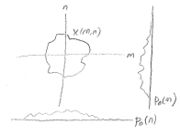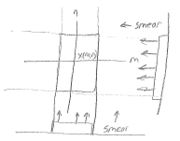Communication Networks Signal and Image processing (CS)
Problem 1,2
Solution 1:
a) $ {{P}_{0}}({{e}^{j\omega }})=\sum\limits_{n=-\infty }^{\infty }{{{p}_{0}}(n){{e}^{-jn\omega }}}=\sum\limits_{n=-\infty }^{\infty }{\left( \sum\limits_{m=-\infty }^{\infty }{x(m,n)} \right){{e}^{-jn\omega }}}=\sum\limits_{m=-\infty }^{\infty }{\sum\limits_{n=-\infty }^{\infty }{x(m,n)}{{e}^{-j(m0+n\omega )}}=X({{e}^{j0}},{{e}^{j\omega }})} $
b) $ {{P}_{1}}({{e}^{j\omega }})=\sum\limits_{m=-\infty }^{\infty }{{{p}_{1}}(m){{e}^{-jm\omega }}}=\sum\limits_{m=-\infty }^{\infty }{\left( \sum\limits_{n=-\infty }^{\infty }{x(m,n)} \right){{e}^{-jm\omega }}}=\sum\limits_{m=-\infty }^{\infty }{\sum\limits_{n=-\infty }^{\infty }{x(m,n)}{{e}^{-j(m\omega +n0)}}=X({{e}^{j\omega }},{{e}^{j0}})} $
The solution used $ v $ and $ \mu $ to represent frequency axis. It used $ w $ to subuslitude both $ v $ and $ \mu $ which is confusing. The solution should stated let $ w=v $ and $ w=\mu $ at (a) and (b).
c)
$ \sum\limits_{n=-\infty }^{\infty }{{{p}_{0}}(n)}==\sum\limits_{n=-\infty }^{\infty }{\left( \sum\limits_{m=-\infty }^{\infty }{x(m,n)} \right)}=\sum\limits_{m=-\infty }^{\infty }{\sum\limits_{n=-\infty }^{\infty }{x(m,n)}{{e}^{-j(m0+n0)}}=X({{e}^{j0}},{{e}^{j0}})} $
d) No, they don’t. From part (a) and (b), we know that $ {{P}_{0}}({{e}^{jw}}) $ and $ {{P}_{1}}({{e}^{jw}}) $ represent the horizontal and vertical axes of the 2D DSFT $ X({{e}^{j\mu }},{{e}^{j\upsilon }}) $, which is not enough for reconstruction of x(m, n). For example, $ {{x}_{1}}(m,n)=\left( \begin{matrix} 1 & 3 \\ 2 & 4 \\ \end{matrix} \right),_{{}}^{{}}and_{{}}^{{}}{{x}_{2}}(m,n)=\left( \begin{matrix} 0 & 4 \\ 3 & 3 \\ \end{matrix} \right) $ have the same $ {{p}_{0}}(n)=\left[ \begin{matrix} 3 & 7 \\ \end{matrix} \right]_{{}}^{{}}and_{{}}^{{}}{{p}_{1}}(m)=\left[ \begin{matrix} 4 \\ 6 \\ \end{matrix} \right] $. So, x(m,n) can’t be reconstructed from $ {{p}_{0}}(n)=\left[ \begin{matrix} 3 & 7 \\ \end{matrix} \right]_{{}}^{{}}and_{{}}^{{}}{{p}_{1}}(m)=\left[ \begin{matrix} 4 \\ 6 \\ \end{matrix} \right] $.
Solution 2:
a) $ {{P}_{0}}({{e}^{j\omega }})=\sum\limits_{n=-\infty }^{\infty }{\sum\limits_{m=-\infty }^{\infty }{x(m,n)} {{e}^{-jn\omega }}}=X({{e}^{j0}},{{e}^{j\omega }}) $
b) $ {{P}_{1}}({{e}^{j\omega }})=\sum\limits_{m=-\infty }^{\infty }{\sum\limits_{n=-\infty }^{\infty }{x(m,n)}{{e}^{-jm\omega }}}=X({{e}^{j\omega }},{{e}^{j0}}) $
To be consistent with the problem statement, frequency notation$ \mu $ corresponds to the spatial notation $ m $ and is the first parameter. As a result, the solution of the (a) and (b) can be switched.
c) They do not; $ {{p}_{0}}(n)\ and\ {{p}_{1}}(m) $ are projections at two angles, and do not contain enough information to reconstruct x(m,n).
$ \begin{align} & X({{e}^{j\mu }},{{e}^{j\upsilon }})=\sum\limits_{m=-\infty }^{\infty }{\left[ \sum\limits_{n=-\infty }^{\infty }{x(m,n)} \right]}{{e}^{-jm\mu }}{{e}^{-jn\upsilon }} \\ & X({{e}^{j\mu }},{{e}^{j\upsilon }})\ne \sum\limits_{m=-\infty }^{\infty }{{{p}_{1}}(m)}{{e}^{-jm\mu }}{{e}^{-jn\upsilon }}\ne {{P}_{1}}({{e}^{j\mu }}){{e}^{-jn\upsilon }} \\ & \Rightarrow Can't\ do\ it! \end{align} $
- To form reconstruction, need projections along many angles.
- Could reconstruct a very simple object, like triangle.
Related Problem
1.Let g(x,y) = s'i'n'c(x / 2,y / 2), and let <span class="texhtml" />s(m,n) = g('T,n'T) where T = 1.
a) Calculate G(μ,ν) the CSFT of g(x,y).
b) Calculate S(ejμ,ejν) the DSFT of s(m,n).
2. Assume that we know (or can measure) the function
$ p(x) = \int_{-\infty}^{\infty}f(x,y)dy $
Using the definitions of the Fourier transform, derive an expressoin for F(u,0) in terms of the function p(x).
(Refer to ECE637 2008 Exam1 Problem2.)



